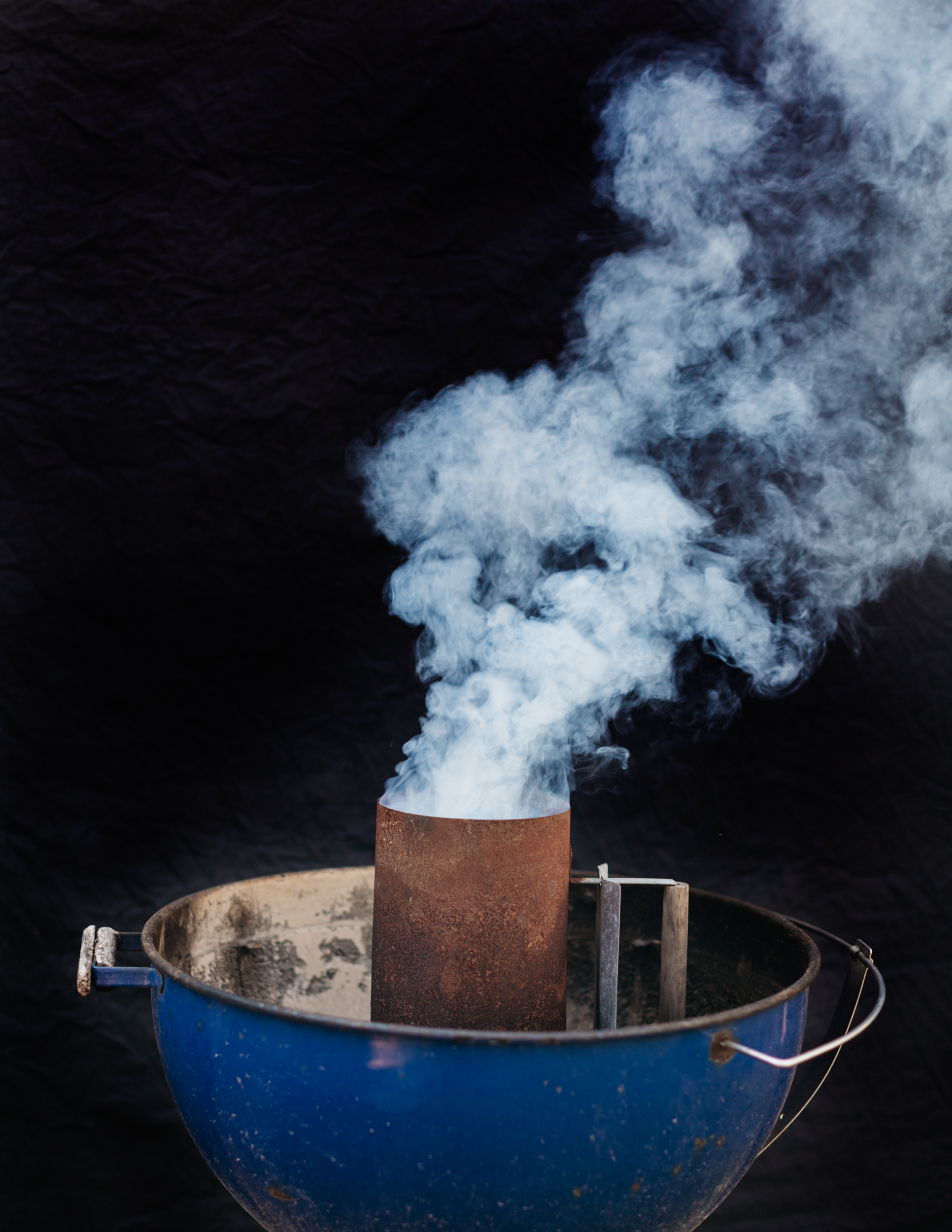Playing with Fire: Backyard Smoking for the Standard Grill
Photo by Michael Piazza / Styled by Catrine Kelty
The magic that happens when food meets fire and smoke might well be primal, a lingering memory passed on from some early ancestor who was led nose-first to feast on a smoldering mastodon. Maybe it’s more recent, the memory of hot dogs and marshmallows roasting over the embers of a campfire. Probably, it’s even simpler: Food kissed by fire and smoke tastes amazing. Taste is the reason I’ll go with to explain why I cook most meals outdoors and over a fire from the first warm day of spring and until it becomes too cold and rainy in the fall.
The outdoor smoke and fire setup in my Cambridge backyard is as complete as I can make it, although it would never make a true pit master jealous. There are no big-rig smokers or giant firepits, no stacks of hickory or cherry hardwood. Instead, in a narrow stretch of garden between my basement door and bike rack, I have a gas grill that’s always ready to go. It’s great for fast grilling over high heat and gets used almost every night. Next to it is a little upright smoker that looks like R2D2 and is great for slow-smoking ribs or fish or brisket on weekends. Then there’s a charcoal kettle grill—it’s the Swiss Army knife of outdoor cooking, a go-to tool that can do just about anything.
The foods that find their way to smoke and fire there vary by the season. Early spring it might be asparagus and ramps or clams and bluefish. As summer gets into full swing, they’re joined by scallops and tomatoes, corn and lobster. There’s bok choy, chicken wings, lamb, sweet potatoes, turkey, zucchini. Almost anything fresh from the butcher shop, fishmonger or farmers market can end up over the fire. Then there are burgers, sausages, hot dogs, chicken wings and steaks. They’re welcome any time of year.
One of the great things about cooking outdoors is that the richness of smoke is almost enough seasoning by itself. But bit of salt, a drizzle of olive oil and a squeeze of lemon are usually added on the plate. What really says summer to me is topping a beautiful smoked bluefish, chicken or cut of lamb with pinches of parsley, basil and oregano that I grow in pots right next to the grill. It’s the simplest and best kind of summer cooking: rich smoke, bright acid and fresh herbs.
I’m a huge fan of barbecue, the super long and low, smoke-fueled alchemy that’s practiced by hearty souls willing to wake up at 3am to begin hours of feeding the fire, mopping the barbecue and drinking. Those consistent, low temperatures and very long cook times break down collagen and release intense flavor from cuts like brisket, ribs and pork shoulder. Barbecue is delicious and definitely worth a drive out of the way to find the good stuff in Texas or North Carolina or Memphis. But it requires more time, patience and temperature control than I can pull off in Cambridge on a weekday. As good as it is, true barbecue is more of a commitment than I’m willing to take on most weekends.
Instead, the cooking that satisfies my need for smoke is better described as low-ish and slow-ish. This is also low-stress, low-fuss cooking that I can pull off on the kettle charcoal grill, even on a weeknight. It’s as simple as building a small charcoal fire, adding hardwood for flavor, setting the grill for indirect heat and checking your meat thermometer (tips follow.)
Rather than relying on 12 hours of low heat and smoke to tenderize those tough but tasty cuts, this cooking welcomes a greater variety of foods: turkey and lamb, bluefish, monkfish, and even grains like farro. These foods cook faster, take on smoke beautifully and are a little more forgiving. Heat too high? Move the food farther away from the heat source or take the lid off the grill for a while. Fire dying out? Light a few more coals in the chimney and add them to the fire. Don’t want to spend the whole day tending a fire? No problem. All of the dishes here can be accomplished in a few hours. They might not be as primally satisfying as charred mastodon, but they’re far more manageable on a summer weeknight.
Fire, good! Here are a few tips for starting and maintaining a charcoal fire for these recipes.
Use chimney starter rather than chemicals. It’s faster and tastes better.
Fill the chimney about one third full. Wait until coals are ashed over to add to the grill.
Keep a few hot coals burning in the starter. You’ll always have coals to add if the temperature drops on the grill.
None of the recipes here require many coals. If the fire looks a little small, it’s probably right.
Smoke ’em if you got ’em
The physics of a kettle grill aren’t great for holding a constant low temperature for 12 hours of slow smoking. But it works fine for shorter periods.
Build a small fire on one side of the grill.
Place a foil pan filled with water next to the fire.
Top the coals with hardwood chips or chunks. Remember: More isn’t always better when it comes to smoke.
Pat meat or fish dry before you smoke them. Smoke permeates dry foods better.
Place whatever you’re smoking on the cool side of the grill.
Put the lid on with vents open, positioned directly above the food. This helps draw smoke across.
Use a thermometer to keep an eye on both air and food temperatures.
Aim to keep the temperature inside the grill at about 200° to 250°.
Don’t open the lid too often, but check and add coals if needed.
This story appeared in the Summer 2018 issue.






